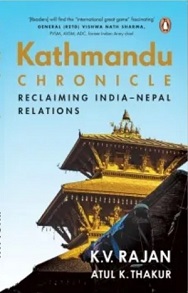Long before the Christian era, Indians had the knowledge of monsoon winds. And Indians started sailing, not only before the European explorers of 14th centuries and around, but Indians sailed even before Hippalus, the Greek mariner, famous for discovering the monsoon winds. In fact, the people of Indus Valley Civilisation were already using seasonal monsoon winds also known as trade winds and currents for maritime trade and navigation since 2500 BC, or even before. The above statement, substantiated by some Vedic and Sangam period texts, and some archaeological evidences, might appear to be a tall claim to many. Yet, this is where the book scores the most. By countering the mainstream history, which is often biased and written as per the rulers of the time, the book tries to acknowledge and appreciate some lesser-known actors, who lost their rightful mention in the history. Studying history, the contribution of Indian traders in African civilisation appears to be negligible. Yet, some written reports, articles, even stories, carefully ignored by western and oriental historians alike, bear the witness of immense contribution this Indian community made over the development of Eastern Africa, including the islands located in South-Eastern Africa.
An attempt to capture the history of three thousand years, a history that is not mainstreamed, in itself is a bold attempt. And countering the hegemons of the discipline could most certainly ruffle some feathers of mainstream historians and alike. Some may also ignore this as a naïve approach to writing history. However, it is only due to the insufficient scholarly work on this domain that the claims of the book appear connecting the big dots. On the positive side, the insights of the book are so plentiful that it should lead to multiple researches doing justice to some unsung peoples of the history.
The origin of the book traces back to some childhood curiosity of the author, the similarities between the street vendors in Nairobi, Kenya and Karachi, Pakistan. Despite being separated by Indian Ocean, how did these people manage to connect, survive and to some extent, thrive. This simple enquiry took the author to travel from Kenya, to present day Tanzania to Mumbai and Goa in India. And the result is indeed a script that challenges the Western modes of history writing, which can be too narrow in its attempt to capture plurality and from the perspectives of colonisers, too dominant in its tone.
The biggest challenge towards countering the dominant narrative for the author was, as always, lack of written evidence. While there can be ample of reasons to explain the absence of record, including those destroyed by the colonisers themselves or poor record-keeping, the author chose to emphasise the illiteracy among the Indian traders as the most important reason. It is true that the business class of India (baniyans) were not the most educated class. However, the written evidence of their daily record, such as business deals, could also be an important component towards understanding their roles and responsibilities.
In any case, in the absence of adequate solid evidence, written or archaeological, the author often had to rely on diverse sources including some non-academic books and reports along with some colonial British documents. To that end, the statements of some representatives of British Government, such as John Kirk and Sir Bartle Frere are almost over cited. The author also quotes evidences contained in the Vedas and Puranas, as well as fromPtolemy, the Bible, and the Ramayana. The Rig Veda, the oldest literary work of the Indian subcontinent as well as the later Vedic period texts, lucidly mention the monsoon winds, and oceanic circulations and terms related to ships and shipping. Despite the unscholarly nature of some of these sources, they reflect the realities of that time and cannot be ignored.
Some connections that the author made between ancient Hindu texts and current realities are astonishing. Who could have known that the Lohita Sagar of Ramayana is actually what we know as Red Sea or the Miair in Purana is present day Egypt? Thinking of it, the Arabic name of Egypt is Misr and Egyptians themselves refer to Egypt as Misr even today. Considering the name of Egypt kept changing multiple times, a little in-depth research on the timeline will be useful to establish or refute these connections. Likewise, the similarities between the mystical places mentioned in Mahabharata and of Uganda or sea birds in Jataka with the ship guiding crows are indeed uncanny. The same goes for the Puranic name of River Nile as Krishna and Lake Victoria as Dev Sarovar. Be as it may, these connections need more work and can lead to even deeper connection. Unfortunately, also due to the nature of documents the author had to consult, it is not easy to develop an impeccable bibliography. Thereupon, the composition of the bibliography remains little weak as some of the documents cited could not be properly dated.
Some exciting details emerge from the book. The Indians who linked Bombay and other western Indian ports with Zanzibar, and how that contributed to the growth of Zanzibar as regional business hub is fascinating. There is mention of some important Indians who played a large role not only in the development of the region but also in fighting for Indian rights such as A.M. Jeevanjee, Jairam Shewji or Tharya Topan. The list of plants introduced by Indians at different periods of history is an interesting read. A similar but different study where how the African agricultural system influenced Indian agriculture would be an interesting read. The politics played by the British over the abolition of slavery is also an eye-opener. And the description of making of Ugandan railway can give any reader shivers. It is a pity that the amount of hardships the Indian labours had to go through to build the railway line and the financial contribution of Indian merchants is nowhere in the pages of history and the whole credit is usurped by the British.
The book also details the interactions between Indian merchants along with other merchants of that time. There is a vivid description of how British merchants played all the tricks to capture the trade network already developed by Indians and Arabs. First, they entered as another merchant class. Then in the name of providing protection to their Indian colonial subjects, they took the control from the local rulers. And most of the times, this was done using unfair means. Once established, they used divide and rule to engage Indians and Africans in bitter battles and took advantage of the situation. The connection between scramble for Africa of 1884 in Berlin and their large impact in trade networks of East Africa is well explained.
These days, when we read about India’s Africa connection, it starts with Mahatma Gandhi and how his political journey started in South Africa. But definitely the connection between India and Africa doesn’t start there. The indentured labour of late 19th and early 20th century precedes the political adventures of Gandhi. There is considerable work towards highlighting the contribution of these indentured labour. But this book travels further back and brings out the details of those who didn’t find place in the history of that time, of that region. The book, in that way, forms a eulogy of Indian merchants and expected to instil a sense of pride among their descendants. It is also a very interesting read for the students of historiography, more in inductive way, rather than deductive. For that matter, the book is a collection of several important events, personalities and it has no place for any theory building. The book should encourage the scholars of Indian Diaspora as well as Indian Ocean Studies to dig deeper, create academic debates and bring out more interesting and important details.
The hardship sustained by generations of Indians and their significant contribution towards the development of the country they settled in, should be a matter of pride for the Indian diaspora living there. The book was first published in Nairobi, Kenya in 2008. Considering the importance of the book in establishing the contributions of these little-known Indian merchants in the development of Eastern Africa and reviving the sense of justifiable pride among the Indian Diaspora, the book is being reprinted in India. The study of history has always been a disputed territory, with multiple interpretations and perspectives of a single event. Only with the emergence of new facts or evidences that can challenge previous interpretations, an exercise to engage with the existing historiography can be undertaken and an amendment, if required, can be made. This book is a perfect example of what is needed to rekindle the interest for scholars of historiography to question the existing scholarship and rewrite history bereft of any ideological moorings.











Great article.
Post new comment